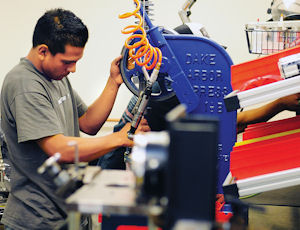Today’s headlines about surging construction spending and projections of a double-digit rise in skilled trades jobs over the next decade are promising indicators of Southern California’s long-term economic prospects. That is, if we can find the workers.
A projected shortage of skilled trades labor could delay or derail many of these projects, and that should be an urgent concern for an array of economic development stakeholders – for companies contracted to deliver much-needed roads, power systems and housing; for policy makers responsible for public infrastructure work; and for education leaders who have a tremendous opportunity to prepare young people for the jobs of the future.
One area to focus on is skilled trades education at the middle and high school levels. Over the last two decades, these courses have all but vanished.
One area to focus on is skilled trades education at the middle and high school levels. Over the last two decades, these courses have all but vanished.
A new survey commissioned by Harbor Freight Tools for Schools, a program of the Smidt Foundation, found a supermajority of Los Angeles County voters, parents, and students want local high schools to reestablish and invest in skilled trades programs.
The findings show that students, parents and voters believe skilled trades education offers a viable pathway to high-paying jobs and resilient careers in industries that are seeing a booming demand – not to mention rapidly aging and retiring workforces. They support exposing students to future work opportunities and giving them a head start on training before they graduate.
I couldn’t agree more. My father, the late Paul Matt, learned the skill of welding as a young man, which led him to become a member of the construction team that built The Dalles Hydroelectric Dam in Oregon. This experience sparked his lifelong fascination with construction.
He later earned a structural engineering degree from Oregon Institute of Technology, which led to a position as a surveyor – a skilled trade in our industry – and later as a project superintendent, playing a lead role in building the Salk Institute in San Diego. Decades later Paul, his brother Al, and I co-founded Matt Construction which has become known for undertaking signature projects, including the Skirball Cultural Center, The Broad, the Waldorf-Astoria Hotel in Beverly Hills and the restorations of both Wilshire Boulevard Temple and the Hollywood Bowl.
Becoming a welder in the early 1950s was a crucial first step in a meaningful and rewarding career. While the world has changed so much since then, the role of skilled trades in creating valuable career paths is as relevant as ever. Yet, we hear from subcontractors on a regular basis about the challenges they face recruiting skilled trades workers. At the same time, the high dropout rate of our high schools suggests we need to provide a compelling reason to stay in school – a viable career path with entry-level opportunities – for young people who choose not to go to college. We need to bridge these gaps.
Bringing back skilled trades education to middle and high schools is essential. They are the right places to begin offering skilled trades courses. The survey respondents agreed. Large majorities – 84% of voters, 89% of parents, and 83% of students – expressed support for increasing state and local funding to expand skilled trades offerings in local public high schools. Three-quarters of parents said they would encourage their child to take a skilled trades class if it was offered, regardless of whether their child was college-bound.
In my case, the skilled trades classes I took in middle school and high school played a formative – even inspirational – role in my career: through learning and practicing these skills, I learned how to analyze problems and gained confidence in my problem-solving capabilities. Those classes – drafting, carpentry, and metalworking – and the more general understanding they instilled have stuck with me ever since.
Moving forward, it is important to create a modern blueprint for delivering quality skilled trades education to Southern California teens. There is no magic lever to pull or turn. What is required is a broad, comprehensive approach that engages school systems, employers, labor unions, parents, and students to revive and scale high school skilled trades education.
To underscore the importance of meeting the challenge, a new report by the National Skills Coalition estimated that recently passed federal programs should infuse $2 trillion in U.S. infrastructure projects, creating an average of 2.9 million jobs a year for the duration of the programs. The report’s authors warn that the number of currently trained workers is insufficient to handle the demand.
The urgent conversation needs to get started. Let’s start with some simple questions: Who is going to build future airport or Metro projects, housing units, solar arrays, museums, power grids, and other infrastructure of the future in Los Angeles? Equally important, how do we ensure that young people grow up with a real chance of achieving the American Dream?
The answer is clear. Young people in Los Angeles must have the opportunity to learn the trades and graduate from high school armed with the necessary skills to be hired in entry-level jobs leading to genuine careers. In my late father’s experience, the ability to work with his hands as a skilled welder opened the door to a career of wonder and opportunity. Let’s make sure that today’s young people have that same chance.
Steve Matt is chair and chief executive of Matt Construction, a company he founded with his father, Paul, and and uncle, Al. Its projects include the Waldorf Astoria Beverly Hills, the Academy Museum of Motion Pictures, The Broad and The Wrapper.
